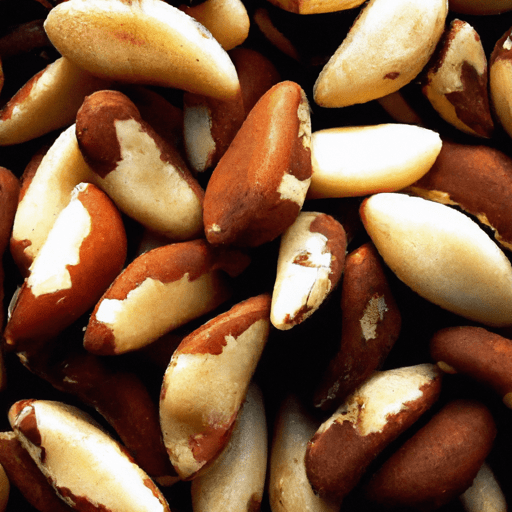Exploring the Versatility of Brazil Nuts in Cooking
If you’re on the lookout for a delicious, nutrient-packed nut to add to your cooking repertoire, look no further than the magnificent Brazil nut. This large, crescent-shaped nut, native to the Amazon rainforest in South America, is not only a delight for the taste buds but also offers a wide variety of culinary applications. In this blog post, we’ll dive into the world of Brazil nuts, exploring their taste, common uses in cooking, nutritional value, and some fascinating history and facts.
Taste and Texture
Brazil nuts boast a rich, creamy texture with a subtle, buttery flavor. When consumed raw, they are slightly sweet with a hint of nuttiness. Once roasted, their flavors become more robust and intense, enhancing both sweet and savory dishes.
Culinary Uses
Brazil nuts are incredibly versatile and can be enjoyed in numerous ways:
Snacking
Brazil nuts are a popular choice for snacking, whether raw or roasted. Their unique texture makes them an excellent standalone treat, pairing perfectly with your favorite beverage or enjoyed on their own.
Baking and Desserts
These flavorful nuts can add a delightful crunch and enhance the taste and texture of various baked goods. From cookies, cakes, and muffins to pies and tarts, Brazil nuts make a delectable addition to any sweet treat.
Nut Butter
Move over, peanut butter! Brazil nut butter offers a rich, velvety alternative for toast or as a dip for fruits and vegetables. You can also incorporate it into smoothies or use it in dressings and sauces for added depth and creaminess.
Savory Dishes
Brazil nuts add a touch of indulgence to savory recipes. Crushed or ground, they work wonderfully as a coating for meats and fish, adding both flavor and texture. You can also sprinkle them over salads, roasted vegetables, or stir them into savory grain dishes for an exquisite twist.
Nutritional Powerhouse
Besides being an absolute treat for your taste buds, Brazil nuts are packed with essential nutrients:
Healthy Fats: Brazil nuts are an excellent source of heart-healthy monounsaturated fats, particularly omega-6 fatty acids. These fats promote optimal brain function and provide long-lasting energy.
Powerful Proteins: A handful of Brazil nuts provides a significant protein boost, making them an excellent addition to a vegetarian or vegan diet.
Mineral Magic: These nuts are a fantastic source of selenium, a powerful antioxidant that supports immune function, thyroid health, and may even aid in cancer prevention. Just a couple of Brazil nuts can fulfill your entire daily selenium requirement!
Vitamin E: This nut is also abundant in vitamin E, an antioxidant that helps protect your cells from damage, supports healthy skin, and boosts overall immunity.
History and Fun Facts
Brazil nuts have a rich history rooted in the Amazon rainforest. They have been a staple in indigenous diets for centuries and played a significant role in both their cuisine and cultural practices. In fact, Brazil nut trees require the assistance of a specific orchid bee for pollination. This unique relationship between the Brazil nut tree and the orchid bee highlights their interconnectivity in the Amazon ecosystem.
Another fascinating fact about Brazil nuts is their distinctive packaging. These nuts come encased in spherical pods that resemble coconuts. Each pod holds around 10-25 seeds or “nuts,” which are carefully hand-harvested by local gatherers, known as castanheiros.
Time to Embrace Brazil Nuts in Your Cooking!
With their luxurious taste, incredible versatility, and impressive nutritional profile, Brazil nuts have earned their place in the repertoire of any food enthusiast. Whether you enjoy them as a snack, incorporate them into your baking endeavors, or experiment with surprising savory combinations, these nuts will undoubtedly add depth and complexity to your favorite recipes. So go ahead, embrace the wonders of Brazil nuts and elevate your culinary creations to a whole new level!
Origin: Brazil nuts are native to the Amazon rainforest in South America, primarily found in Brazil, Bolivia, and Peru. They come from the Brazil nut tree, scientifically known as Bertholletia excelsa, which belongs to the family Lecythidaceae.
Common Uses: Brazil nuts are commonly enjoyed raw or roasted as a snack. They are also used in various culinary applications, including desserts, baking, granolas, trail mixes, and as a topping on salads or oatmeal. Brazil nut oil, extracted from the nuts, is used in cooking and as a natural moisturizer in beauty products.
Nutritional Benefits: Brazil nuts are highly nutritious. They are an excellent source of selenium, which is essential for proper thyroid function, DNA synthesis, and a healthy immune system. Just one ounce (28 grams) of Brazil nuts can provide more than 100% of the recommended daily intake of selenium. They are also a good source of healthy fats, protein, fiber, magnesium, phosphorus, and vitamin E.
Unique Properties: Brazil nuts are known for their large size and distinct triangular shape. They have a creamy, rich flavor with a slight bitterness. One interesting property of Brazil nuts is their high selenium content, which is higher than any other commonly consumed nut. However, it is important to consume them in moderation as excessive selenium intake can be harmful.
Historical Significance: Brazil nuts have been an important part of the diet of indigenous communities in the Amazon rainforest for centuries. They were first discovered by European explorers in the 16th century during their expeditions to South America. During that time, they were highly valued and exported to Europe. Today, Brazil nuts are one of the most economically important non-timber forest products from the Amazon region.




Use the share button below if you liked it.
It makes me smile, when I see it.